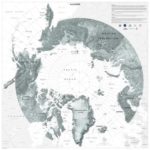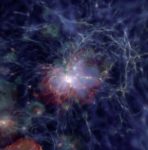Dr. Brett Bode from NCSA gave this talk at the HPC User Forum. “Blue Waters is one of the most powerful supercomputers in the world and is one of the fastest supercomputers on a university campus. Scientists and engineers across the country use the computing and data power of Blue Waters to tackle a wide range of challenging problems, from predicting the behavior of complex biological systems to simulating the evolution of the cosmos.”
Supercomputing Earth’s Geomagnetism with Blue Waters
Researchers are using the Blue Waters supercomputer at NCSA to better understand geomagnetic variations and their underlying mechanisms, so that better forecasting models can be developed. “Without Blue Waters (or any comparable computing facilities), we would have to scale back our ensemble size in order to complete all simulations within a reasonable time frame. This will certainly limit our ability to achieve meaningful research and application goals.”
NCSA to help build world’s most powerful geospatial system
NCSA has announced a new collaboration to produce digital elevation models (DEM) of the entire Earth, among other geospatial research projects. “This is the beginning of building a long-term strategic relationship between NGA and the University of Illinois, centered on high-performance computing and data analysis. The Blue Waters collaboration is the first of what we anticipate will be many years of research collaborations between NGA and Illinois faculty as well as NCSA.”
Deep Learning for Higgs Boson Identification and Searches for New Physics at the Large Hadron Collider
Mark Neubauer from the University of Illinois gave this talk at the Blue Waters Symposium. “In this talk, we present our work using deep learning techniques on the Blue Waters supercomputing to develop and optimize a novel method of identifying the decays of highly-boosted Higgs bosons produced at the LHC a signature of new particles and/or phenomena at the energy frontier of particle physics. We also discuss our ongoing work using Blue Waters to develop scalable cyberinfrastructure for sustainable and reproducible data analysis workflows through the NSF-funded IRIS-HEP Institute and SCAILFIN project.”
Video: Supercomputing Sediment Transport in Estuaries
In this video, Salme Cook from the University of New Hampshire describes how she is using NCSA’s Blue Waters supercomputer to model estuaries. One of the big challenges oceanographers face is the inability to observe their science directly. Cook is focused on modeling two particular estuaries in New Hampshire that are experiencing water quality degradation.
Bill Kramer to Lead Pittsburgh Supercomputing Center
William Kramer has been selected as the next director of the Pittsburgh Supercomputing Center. “It’s our great fortune to recruit Bill, who is known and honored nationally for his leadership and innovations in the world of supercomputing,” said Rob A. Rutenbar, senior vice chancellor for research at the University of Pittsburgh. “In many ways, his career path is emblematic of the role of supercomputing in modern scientific research. The field has grown specifically because of his innovations and commitment.”
Simulating Hurricanes with the Blue Waters Supercomputer
In this video, researchers describe how they are using the Blue Waters supercomputer at NCSA to figure out the effects of a changing climate on the frequency and intensity of hurricanes. “We couple the atmosphere model to the ocean because tropical cyclones get their energy from the warm, near-surface waters. We wanted to see what is the effect of climate-induced changes in the ocean on the storms themselves when we go to a fully coupled, high-resolution climate model configuration.”
Supercomputing the Formation of Black Holes
New research based on simulations using the Blue Waters supercomputer at NCSA reveals that when galaxies assemble extremely rapidly — and sometimes violently — that can lead to the formation of very massive black holes. In these rare galaxies, normal star formation is disrupted and black hole formation takes over. “We on the Blue Waters Project are very excited about this accomplishment and very pleased that Blue Waters, with its unique capabilities, once again enabled science that was not feasible on any other system,” said Bill Kramer, the Blue Waters Principal Investigator and Director.
Supercomputing Dark Energy Survey Data through 2021
Scientists’ effort to map a portion of the sky in unprecedented detail is coming to an end, but their work to learn more about the expansion of the universe has just begun. “Using the Dark Energy Camera, a 520-megapixel digital camera mounted on the Blanco 4-meter telescope at the Cerro Tololo Inter-American Observatory in Chile, scientists on DES took data for 758 nights over six years. Over those nights, the survey generated 50 terabytes (that’s 50 trillion bytes) of data over its six observation seasons. That data is stored and analyzed at NCSA. Compute power for the project comes from NCSA’s NSF-funded Blue Waters Supercomputer, the University of Illinois Campus Cluster, and Fermilab.”
Leadership Computing and NSF’s Computational Ecosystem
Irene Qualters gave this talk at the HPC User Forum in Detroit. “For over three decades, NSF has been a leader in providing the computing resources our nation’s researchers need to accelerate innovation,” said NSF Director France Córdova. “Keeping the U.S. at the forefront of advanced computing capabilities and providing researchers across the country access to those resources are key elements in maintaining our status as a global leader in research and education. This award is an investment in the entire U.S. research ecosystem that will enable leap-ahead discoveries.”













